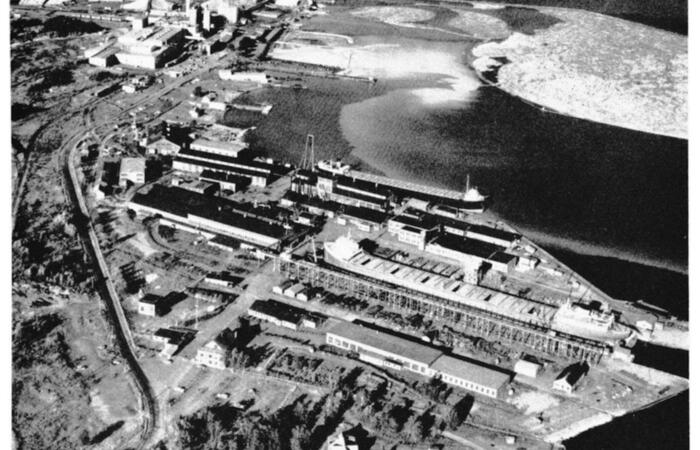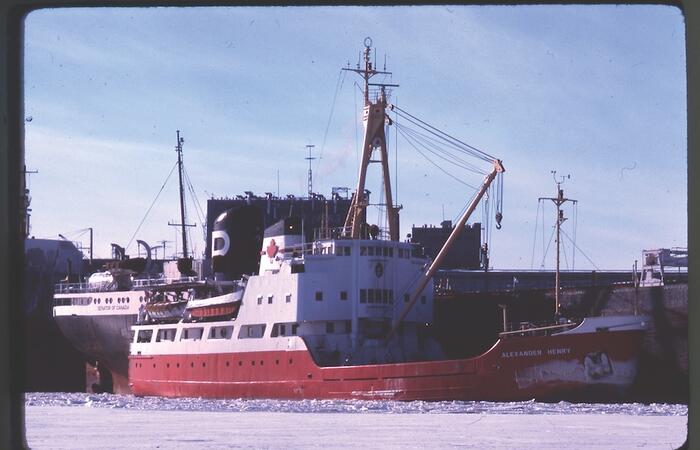The Lakehead was built upon the industries that grew from its rich natural resources. Initially, the abundant wildlife provided a source of pelts that would sustain a fur trade for three centuries until the late 1800s. With the arrival of the transcontinental railway in the 1880s, grain grown on the prairies could be shipped by rail to the Lakehead and loaded on ships bound for countries all over the world. The vast forests provided the wood for construction and pulp and paper. And the shores of Port Arthur provided the right geography for a shipbuilding yard to thrive.
PORTSHIP
Shipbuilding at the Lakehead was born in 1908 when the Canadian government put a 25% duty on Canadian ships repaired in the United States. This prompted the American Shipbuilding Company (AMSHIP) to investigate forming a Canadian subsidiary of the company. AMSHIP decided on the shores of Port Arthur which had a rocky ledge at the north end of the harbour were suited to build a 747 x 98 foot dry dock as well as a foundry and other supporting structures. The new company would be called the Port Arthur Shipbuilding Company (PORTSHIP) with AMSHIP retaining 80% ownership. The Canadian Government granted AMSHIP a 3% annual bonus on the cost of all equipment used as well as tax relief for 20 years. The remaining 20% ownership would be in Canadian hands with James Whalen of Port Arthur as PORTSHIP's first president. In 1910, construction of the dry dock and supporting buildings such as the punch shed, machine shop, electrical and pipefitters shops. By 1912, work was complete at an estimated cost of $650,000.The first ship built at PORTSHIP was a dump scow unceremoniously named scow No. 45. It was launched on June 27 of that year. Over its lifetime, the Port Arthur Shipbuilding Company built 129 ships including canallers, stern wheelers, tow boats, scows, corvettes, minesweepers, dredges, a passenger ferry, bulk carriers, freighters and tankers.
PORTSHIP’s success was due in large part to its complete facilities. It could build and repair ships of steel, aluminum, wood and plastic construction. Dry dock and building berths were serviced with locomotive, gantry and whirley type cranes. Well equipped steel fabrication shops, machine shops, pattern, foundry, blacksmith shops; joiner, paint, pipe and electric shops kept a large inventory of material and supplies. PORTSHIP was able to handle any job.
End of an era
After 84 years in business, PORTSHIP became Port Arthur Shipbuilding Company Ltd. (PASCOL) Engineering. The name change symbolized the end of an era and represented the new reality of an economic restructuring of industries occurring across Canada. The market for construction and repair of ships was steadily declining. On February 3, 1993, President of Canadian Shipbuilding and Engineering (CSE), Stewart M. Thomas, announced Port Arthur Shipbuilding would close effective June 30. He cited that work had steadily dropped to 62,000 person hours over the previous year from 460,000 hours in 1982. CSE could not foresee this downturn reversing. Hence, they submitted a plan to downsize the company to the federal and provincial governments. The CSE's rationalization plan was accepted with a promise of financial assistance from both levels of government.
PASCOL Engineering
When the last ship in the dry dock, the Alcogen, was launched, PORTSHIP officially became PASCOL Engineering. PASCOL would be a much downsized company employing only 52 of PORTSHIP’s workers. The new company would not construct and repair ships. It concentrated on making pulp and paper, forestry, mining and railway equipment. But even the restructured company couldn’t withstand the changing economic times. On March 2, 2007, PASCOL Engineering went into receivership and was acquired by the Upper Great Lakes Group Inc. Thus the shipbuilding industry in the Lakehead came to a final close.
The Henry is home
Locally, the most famous ship to be built at PORTSHIP is the Alexander Henry icebreaker named after the 18th century British explorer and fur trader. First launched in July 18, 1958, the 210 ft. long vessel plied the Great Lakes breaking the ice and supplying lighthouses, including the Port of Thunder Bay, until she was decommissioned in 1984. The ship was turned over to the Maritime Museum of the Great Lakes in Kingston where she became a floating maritime gallery. Then, 33 years later, The Lakehead Transportation Society had the opportunity to purchase her for $2.00. They did. The City of Thunder Bay provided the $125,000 cost to tow her to here from Kingston. On June 28, 2017, the Alexander Henry arrived back in Thunder Bay where she is docked at the Pool 6 site to serve once again as a museum. The Henry is home to stay. This is where she belongs moored on the shores where she was made and worked. She stands as a legacy showcasing our proud shipbuilding past and serves as a beacon of hope that shipbuilding might one day return to the shores of Thunder Bay.





